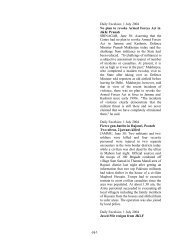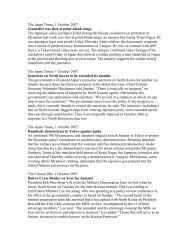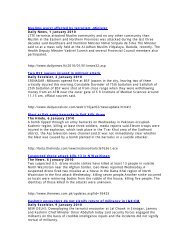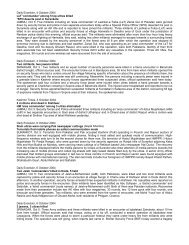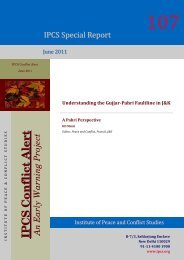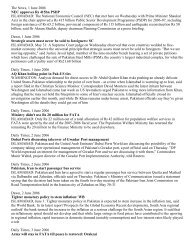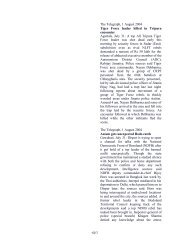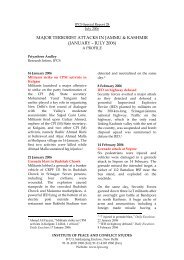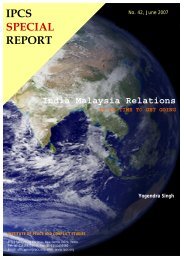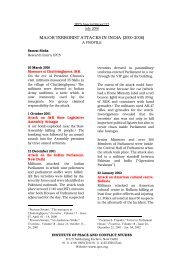India and Southeast Asia: A Personal Narrative from Chennai
India and Southeast Asia: A Personal Narrative from Chennai
India and Southeast Asia: A Personal Narrative from Chennai
Create successful ePaper yourself
Turn your PDF publications into a flip-book with our unique Google optimized e-Paper software.
IPCS SPECIAL REPORT #139, MARCH 2013<br />
Kumar Singh has argued “such a facility is essential if the <strong>India</strong>n Navy is to protect<br />
<strong>India</strong>n sea-borne trade <strong>and</strong> ONGC oil exploration in South China Sea (23).<br />
The question naturally arises as to - how will <strong>Southeast</strong> <strong>Asia</strong>n countries respond in case<br />
of a likely rift between <strong>India</strong> <strong>and</strong> China or China <strong>and</strong> the United States? It may be<br />
recalled that during the Sino-<strong>India</strong>n Conflict, 1962, Federation of Malaya, Thail<strong>and</strong>,<br />
South Vietnam <strong>and</strong> the Philippines extended their whole hearted support to <strong>India</strong>.<br />
Burma, Cambodia <strong>and</strong> Indonesia were neutral in the dispute. The only country which<br />
supported China was North Vietnam, the reason being Hanoi’s dependence on Beijing<br />
for economic <strong>and</strong> military support at that time.<br />
Two illustrations are given below which will give a clue to the changing perception of<br />
<strong>Southeast</strong> <strong>Asia</strong>n countries towards <strong>India</strong> <strong>and</strong> China. In his recently published memoirs,<br />
SR Nathan, former President of Singapore, describes an incident during Lee Kuan<br />
Yew’s visit to China in 1976. The highlight of the visit was Lee Kuan Yew’s meeting<br />
with the Chinese Prime Minister Hua Gofeng. During the discussion Hua presented<br />
Lee Kuan Yew with a book, saying, “This is the correct account of the war between<br />
<strong>India</strong> <strong>and</strong> China. I hope you will find it useful”. Lee Kuan Yew looked at the book,<br />
looked at the front cover, looked at the back, <strong>and</strong> said, “Mr. Prime Minister, this is your<br />
version of the war. There is another version, the <strong>India</strong>n version. And, in any case, I am<br />
<strong>from</strong> <strong>Southeast</strong> <strong>Asia</strong>. It has nothing to do with us”. He h<strong>and</strong>ed the book back. For me<br />
this was an important moment, a clear confirmation that Lee Kuan Yew, although<br />
ethnically Chinese, was his own man, in no way subordinate to China or the Chinese<br />
communists. We, in Singapore, had a separate, multi-racial identity. What we made<br />
clear is that we should not be taken for granted. The Chinese Foreign Minister Qiao<br />
Guanhua was rather agitated, but kept his cool; his wife did not, <strong>and</strong> walked out of the<br />
room in a huff” (24). Another important incident took place when George Yeo, the<br />
Singapore Foreign Minister, went to China in September 2010. The Chinese<br />
authorities arranged a meeting between their nominee of Panchan Lama <strong>and</strong> George<br />
Yeo. It may be recalled that George Yeo visited Tibet during his earlier visit <strong>and</strong> was in<br />
full praise for China’s efforts to bring about massive economic transformation. What<br />
does the meeting between George Yeo <strong>and</strong> Panchan Lama signal? Does it mean that in<br />
the post Dalai lama phase Singapore will support China’s nominee as the spiritual<br />
leader of the Tibetan people” B. Raman, <strong>India</strong>’s leading strategic specialist, has posed<br />
the question as follows: “The action of the Singapore Foreign Minister in providing<br />
legitimacy to the actions of the Chinese Communist Party in interfering with the<br />
religious affairs of the Tibetan Buddhists <strong>and</strong> tampering with their traditions cannot be<br />
missed” (25).<br />
How does Malaysia, which extended spontaneous support to <strong>India</strong> in October-<br />
November 1962 <strong>and</strong> started the “Save Democracy Fund”, perceive China today? In his<br />
recently published Memoirs, A Doctor in the House: The Memoirs of Tun Mahathir<br />
Mohammad, Dr. Mahathir, the former Prime Minister of Malaysia, has expressed his<br />
views of China c<strong>and</strong>idly. To quote: “I stuck up good relations with the Chinese leaders,<br />
in particular with Ziang Zemin. Malaysia’s goodwill <strong>and</strong> support are well known to most<br />
informed Chinese citizens. China has now become the world’s factory, churning out all<br />
kinds of manufactured goods which are very quickly achieving world st<strong>and</strong>ards. Their<br />
per capita income is below that of Malaysia, but their population makes China a huge<br />
market. Malaysia is China’s largest trading partner in <strong>Southeast</strong> <strong>Asia</strong> <strong>and</strong> our trade<br />
volume continues to grow. I hope our China friendly policy will continue. We must not<br />
fall into the American trap of regarding China as a potential enemy, you can be sure<br />
that country will regard you as its current enemy”. (26).<br />
During the Sino-<strong>India</strong>n<br />
Conflict, 1962, Federation of<br />
Malaya, Thail<strong>and</strong>, South<br />
Vietnam <strong>and</strong> the Philippines<br />
extended their whole hearted<br />
support to <strong>India</strong>. Burma,<br />
Cambodia <strong>and</strong> Indonesia<br />
were neutral in the dispute.<br />
The only country which<br />
supported China was North<br />
Vietnam.<br />
13



